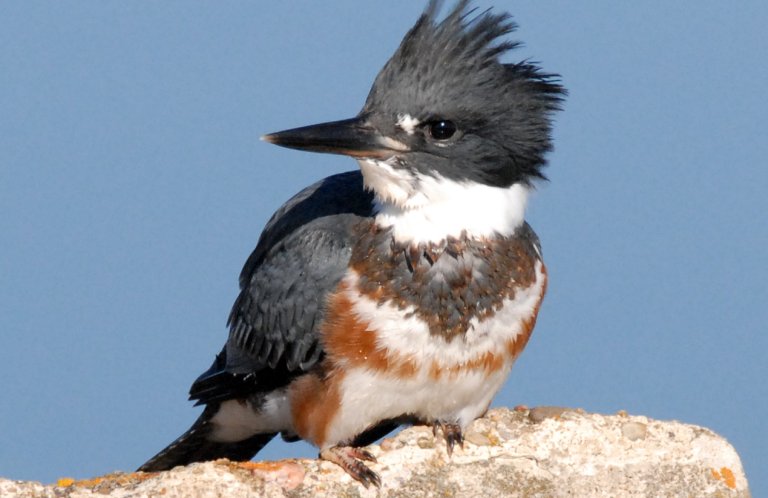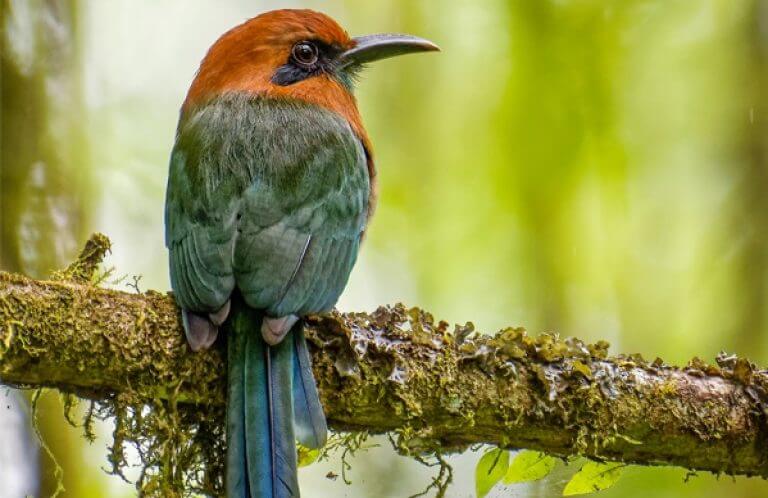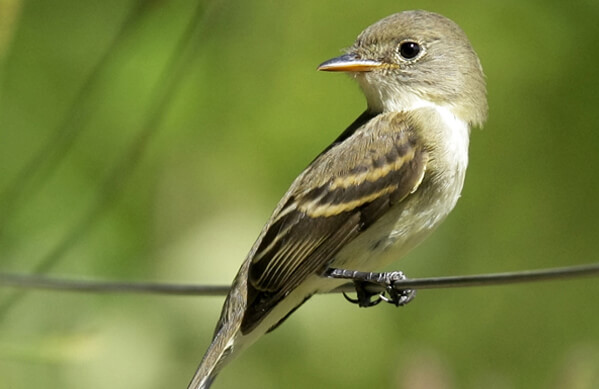About the Green Kingfisher
Smaller and less conspicuous than its noisy relative, the Belted Kingfisher, the Green Kingfisher is a quick-flying sprite of small streams, channels and ponds. At about 8 1/2” long, the Green Kingfisher is roughly the same length as a Northern Cardinal but lighter, although its outsized bill may make it look larger. True to its name, this small kingfisher is dark green with a white collar and green-speckled white underparts. It has white outer tail feathers that are particularly noticeable in flight. The sexes are easy to tell apart: males have a rufous breast, while the larger females have two green bands across a white and buff chest.
Water Kingfisher
The kingfisher family contains nearly 120 species and is so diverse that it has been divided into three subfamilies. The Green Kingfisher is a member of the subfamily called the Cerylinae, or “water kingfishers.” All six New World kingfisher species belong to this subfamily, which specializes in diving for fish.
Many kingfishers in other subfamilies, such as the well-known Laughing Kookaburra (Yes, it's a kingfisher!) of Australia, live away from water in forest, scrub, and arid habitats. Whatever their habitat, all kingfishers have large heads, long, massive bills, and small feet with syndactyl toes (three forward-facing toes, with the outer and middle toes fused about halfway up). This toe arrangement is useful for birds that dig their own nesting holes, like kingfishers and related species such the Broad-billed Motmot.
Songs and Sounds
The Green Kingfisher makes a variety of calls, including a sharp, ticking call, often described as the sound made by tapping two stones together, and a squeaky chatter.
Ticking call:
Chatter:
Breeding and Feeding
The Green Kingfisher is solitary for most of the year, forming monogamous pairs for the duration of each nesting season. Each pair aggressively defends a streamside territory from others of their species. Both male and female work to dig a 2-to-3-foot-long nest burrow in a vertical dirt bank near water. The burrow ends in an enlarged nesting chamber, and its entrance is cleverly concealed by overhanging vegetation or roots. Pairs may re-use nest burrows in successive years.
The female kingfisher lays an average of five white, glossy eggs on the bare ground of the nest chamber. Both parents incubate the eggs for 19-21 days. After the young hatch, the nest chamber floor quickly becomes carpeted with fish bones and scales and insect parts as the parents bring food in to their young. The nestlings fledge quickly, making their first flights less than a month after hatching.

The Green Kingfisher preys on small fish such as minnows, crustaceans, and some aquatic insects. A “visual” feeder, like birds ranging from waterfowl such as the Hooded Merganser to flycatchers like the Eastern Kingbird, the Green Kingfisher hunts by sight. It sits quietly on a low perch over the water until it spots prey, then makes a shallow dive to capture it on or near the water's surface with its bill. Like other diving birds such as the Common Loon, kingfishers have visual adaptations that give them binocular vision underwater, enabling them to judge depth when capturing prey. Nictitating membranes (third eyelids) protect its eyes underwater like a pair of goggles.
Region and Range

Kingfisher of Quiet Waters
Green Kingfishers can be found along still or slow-moving streams, freshwater ponds, and lakes. They require snags, shrubbery, and other low vegetation for hunting perches, and prefers open habitat to dense forest.
The Green Kingfisher is a permanent resident throughout its range. Most abundant in Central and South America, it barely reaches the southwest and south-central U.S. in Arizona and Texas. Five subspecies are recognized, varying slightly in coloration and pattern across the bird's range.
Conservation

Help support ABC's conservation mission!
Habitat loss through development and water pollution, particularly in the U.S., has had negative impacts on the Green Kingfisher. The loss of riparian habitat throughout the American southwest is a particular threat to this species in the U.S., along with other birds of conservation concern such as the Western Yellow-billed Cuckoo, Costa's Hummingbird, Southwestern Willow Flycatcher, and Least Bell's Vireo.
ABC's BirdScapes program also protects important southern riparian habitats through the Rio Grande Joint Venture, which works in a variety of priority bird habitats and working lands for a suite of migratory and resident birds.
Many ABC-supported reserves and other lands throughout the Americas protect populations of Green Kingfisher, from Barba Azul in Bolivia to lands along Guatemala's Conservation Coast BirdScape.
Get Involved
Many of the rarest bird species in the Western Hemisphere remain relatively unknown. You can learn more about these birds and the threats they face by signing up for ABC's Bird of the Week email series, which frequently highlights these fascinating birds.
American Bird Conservancy and our partners throughout Latin America and the Caribbean have created and expanded more than 100 bird reserves, which protect upward of 1.1 million acres of vital habitat. Together, we've planted more than 6.8 million trees, helping to restore degraded and damaged habitat. You can help us continue to protect endangered birds by making a gift today.























































